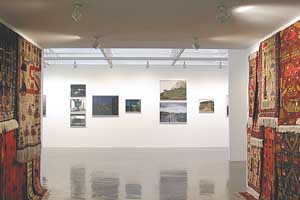Artists explore geography, national identity
By Carrie GolusNews Office
 “Detourism” opens with a display of Afghan war carpets, layered over each other as if hung from a rug stall. The exhibition, curated by Hamza Walker, Education Director for the Renaissance Society museum, is on display until Sunday, Dec. 23. |
“Today the casual ease with which the traditional tourist could experience foreign geographies no longer seems possible.” That anti-escapist sentiment is the theme behind “Detourism,” an exhibition of photography, video, sculpture and site-specific work now on display at the Renaissance Society.
“Detourism,” curated by Hamza Walker, Education Director for the Renaissance Society museum, was partly inspired in response to large international art exhibitions, such as the Venice Biennale, which are divided into national pavilions. “You have to ask, to what extent is the artist expected to represent the sociopolitical climate of each region?” Walker said. “The artwork becomes about the place, not about the artist. And yet the model for these international exhibitions isn’t questioned.”
“Detourism” opens with a display of Afghan war carpets, layered over each other as if hung from a rug stall. “About six months ago I came up with the idea of including Afghan war carpets, and nearly abandoned it. But then September 11 happened, and I thought, I have to put them in,” Walker explained. Ironically––despite the rugs’ prominence at the very entrance to the exhibition––most visitors, like tired shoppers in a crowded bazaar, do not stop to look. “People walk right past them,” Walker said, “somewhat oblivious to their content.”
Inside the exhibition, several artists have drawn on material culture to explore ideas of geography and national identity. On one wall hangs a rack of stark black-and-white T-shirts created by artist Rainer Ganahl. The shirts, part of the exhibition, and yet on sale for $20 (“What could be more touristy than a T-shirt?” said Walker), bear a message in an unfamiliar language, translated in tiny letters on the right sleeve: “Please teach me Pashto.”
On the opposite side of the wall, a display of every postage stamp issued by South Africa throughout its turbulent history is the work by artist Siemon Allen. “Stamps are an example of the way places represent official history, official versions of themselves,” said Walker. “But there are always sub-narratives and off-narratives. In 1976, for example, during the Soweto uprising, what do we see on the stamps? Wildlife! Then 25 years later we have stamps commemorating the anniversary of the uprising, though it was never acknowledged at the time.”
Other artists in the exhibition explore the limits of those accoutrements of tourists everywhere, cameras and video cameras. But while most tourists snap photos as quickly as they can load film, Christopher Williams limits himself to one or two images per place, “and they all have extensive narratives behind them,” Walker said. For example, a photo of a palm tree in Cuba––a cheesy stock-photography image seemingly destined for a travel brochure––was shot on the beach of a private hotel for foreigners, where Williams’ Cuban assistant was not allowed.
Siegrun Appelt’s video Napoli-Roma captures an entire train journey between the two cities, the landscape blurrily rolling by as if glimpsed through a train window. In the opposite corner, David Servoss spins around and around in a frenzy of movement––or perhaps he is still while the landscape moves, as Walker suggested: “Does the artist go around the world, or does the world go around the artist?”
“Detourism” is on display at the Renaissance Society, on the fourth floor of Cobb Hall, until Sunday, Dec. 23. Museum hours are 10 a.m. to 5 p.m. Tuesday through Friday and noon to 5 p.m. Saturday and Sunday.
![[Chronicle]](/images/small-header.gif)